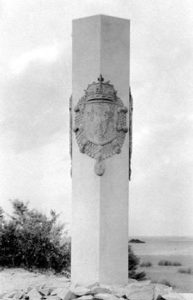There were several expeditions towards Canada
Pierre Chauvin, lord of Tonnetuit, a Huguenot nobleman from Dieppe, went to Saint-Laurent, where he set up the first trading post for selling furs (1599 – 1600). He had intended to set up a settlement of 500 people in Tadoussac at the mouth of Saguenaye but he died just before setting out on a second expedition. On his first journey Pierre Dugua de Mons, a Huguenot nobleman from Royan, was with him and also François Pont-Gavé, a rich merchant from Saint-Malo.
In 1603 the king gave Dugua de Mons the authorisation to set up a trading post in the peninsula that is to the south of the gulf of Saint Laurent – it used to be called Acadia by the French and is now called Nova Scotia.
Dugua de Mons was named lieutenant governor in 1603 by Henri IV and was granted the exclusive rights to deal in furs with the Indians.
He laid the foundations of the Port Royal colony, which consisted of as many catholics as there were protestants (1605). Samuel Champlain, a Huguenot who had converted to catholicism in 1598, went with him.
But in 1607, Dugua d Mons lost the exclusive rights which enabled him to trade with the Indians and the colony was abandoned by the French.
In 1608 a new expedition set out in search of unknown territory, led by Champlain. He discovered Quebec and founded the first permanent French settlement in America.
From 1620 to 1640, this colony was the object of much dispute between the French of Acadia and the English of New England. The English won it initially, then in 1633 it was returned to the French at the treaty of Saint-Germain en Laye.
Later, at the Treaty of Utrecht in 1713 ; the French lost it again.
Business flourished in the area
Business contacts between Acadia and La Rochelle continued until the Revocation of the Edict of Nantes.
The Huguenots could travel freely in the Saint Laurent valley although they were not allowed to practice their religion. In spite of pressure from the clergy, the civil authorities did not object to them being in the colony, although they had never been officially allowed to emigrate. Towards 1620 the merchants of Rouen and Saint-Malo joined forces with a company of merchants in Dieppe which was run by Guillaume de Caën, a protestant and Ezechiel de Caën of the same family, a catholic. This should have had a good effect on business. However religious dissension continually poisoned the atmosphere and in the end Richelieu revoked the monopoly which he had granted to the de Caën family.
Richelieu sent Jesuit missionaries to Acadia
The catholic clergy were very hostile to the Huguenot community in the New France territory and tried to make them abjure their faith or else forced them to flee. So the Church decided to send Jesuit missionaries to Acadia.
Richelieu, the Great Master and Superintendent of Navigation, founded a new company, the “One Hundred Associates” (or New France Company), composed entirely of catholics. Its role was to manage and develop New France from 1627 to 1633. He encouraged catholic missionaries to go out to Acadia but forbid the Huguenots from emigrating to the New World (1627). However, in actual fact he did not prevent the emigration of individual Huguenots, rather, he wanted to make sure that a protestant Church would never be established in the territory. To conclude, although quite a large number of emigrants from La Rochelle went to the New World, the protestants did not succeed in establishing a long-lasting colony there. Louis XIII and Louis XIV did all they could to make things difficult for protestants who wanted to settle on the American continent, so the task was very difficult.
The West Indies
The West Indies held a great fascination for XVIIth century adventurers and many Huguenots went there on an individual basis as they were not officially allowed to emigrate. We know little about this interesting period, apart from the writings of pastor Rochefort (Histoire naturelle et morale des Antilles, Rotterdam, 2e edition, 1665) which gives the impression that the Huguenot refugees lived alongside the Dutch settlers.






